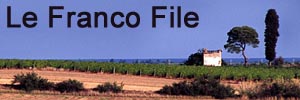We hear that the accursed Jet Stream, that high velocity, high altitude wind that circles the northern hemisphere is messing things up again by being misplaced. As it sweeps from west to east it also oscillates north and south, in sort of sinusoidal wave. It should be (whatever “should” means in a meteorological context) oscillating up above Scotland but is apparently zooming straight up La Manche [English Channel] delivering wave after wave of decidedly stormy weather to much of Europe. Friends of our camping neighbours have been deluged during their first week near Troyes and, with the forecast expecting much the same for their second week, have bailed out and decided to return home early. At the same site, three camper vans had to be towed off waterlogged pitches. Terrific!
The only area that is currently escaping the current spate of weather is the area around the Mediterranean. With the dawm of another grey day, we decided to try and escape the gloom by visiting Gruissan a little south of Narbonne on the Mediterranean coast. Our camping neighbours were looking similarly gloomy so we invited them to come along.
Good decision! After driving for about 20 minutes the solid grey mass above our heads began fragmenting and bits of blue sky appeared. After another 10 minutes, the sky had transformed from grey studded with blue to blue studded with grey. At Gruissan, 30 minutes later again, the great majority of the sky was clear and folks were walking about looking cheerful instead of gloomy – including us.
![]()
 Gruissan is an attractive little fishing port overlooked by Redbeard’s tower. We’ve been here once before on another trip but that was on a Sunday and considerably busier. Today life was considerably calmer with a street market in full swing. I’d thought we’d been lucky to bump into the market unplanned but later we saw a sign implying that it happened on three days of the week so perhaps lucky would be overstating the case. After browsing the market and my buying some colourful casual trousers (seen on male model, right), our companions treated us to lunch in a fish restaurant to thank us for taking them on an escape to an interesting, new (for them) territory.
Gruissan is an attractive little fishing port overlooked by Redbeard’s tower. We’ve been here once before on another trip but that was on a Sunday and considerably busier. Today life was considerably calmer with a street market in full swing. I’d thought we’d been lucky to bump into the market unplanned but later we saw a sign implying that it happened on three days of the week so perhaps lucky would be overstating the case. After browsing the market and my buying some colourful casual trousers (seen on male model, right), our companions treated us to lunch in a fish restaurant to thank us for taking them on an escape to an interesting, new (for them) territory.
 While walking off our lunch, we came across an preserved historic settlement, the “Pech du Moulin”. At least, until we manage to find pech in a dictionary, I’ll assume it was the historic settlement. Here, as well as this old donkey-powered well, there was a stone shelter with yet more filming going on as in the Pyrenees earlier. This time, though, everyone was wearing clothes.
While walking off our lunch, we came across an preserved historic settlement, the “Pech du Moulin”. At least, until we manage to find pech in a dictionary, I’ll assume it was the historic settlement. Here, as well as this old donkey-powered well, there was a stone shelter with yet more filming going on as in the Pyrenees earlier. This time, though, everyone was wearing clothes.
It really is quite amazing how often the Mediterranean manages to punch a whole through what elsewhere is a solid mass of grey. We refer to this as “the Mediterranean effect”. It isn’t foolproof, the Med. does get deluged sometimes resulting in catastrophic flooding, but it seems to work much more often than not. Even the French forecasters comment on “ the sun being put under a cloche in the southeast” and “the sun being cloistered away in the southeast”.
Unfortunately, when the weather is set thus, Fanjeaux is about 30 miles too far west to benefit from the Mediterranean effect. Maybe I could move Luc, Nadine and their farm east to the Corbières?




























Recent Comments